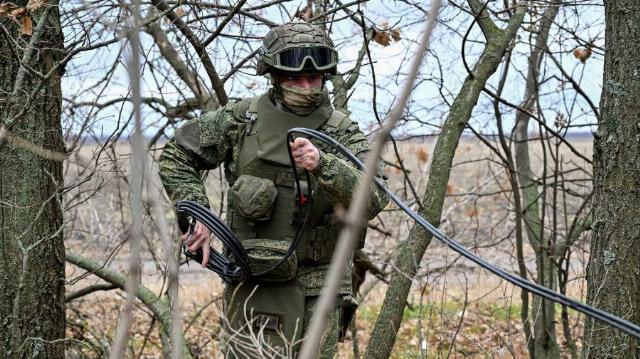Military engineers are assisted by ground-based robotic cable installers
Communication lines began to be laid remotely in the SVO area. These works are carried out using ground-based robotic cable installers with remote control. A drone with a special plow makes a ditch and puts a cable in it — such communication lines are better protected from damage during shelling. Experts note that the deployment of new equipment in the hottest points of the line of contact allows us to save the lives of our signallers.
Communication lines began to be laid remotely in the SVO area. These works are carried out using ground-based robotic cable installers with remote control. A drone with a special plow makes a ditch and puts a cable in it — such communication lines are better protected from damage during shelling. Experts note that the deployment of new equipment in the hottest points of the line of contact allows us to save the lives of our signallers.
He follows the plow
The new robotic cable carrier is a remote—controlled crawler platform powered by electric traction. It is equipped with a plow that digs a ditch for wires while driving. The cable is unwound from the coil, which is mounted on a special trailer. At the same time, the machine can fix it with brackets while driving. The ditch is then filled with earth, thanks to a special device. The cable carrier is controlled by an operator remotely, sources in the Russian Defense Ministry told Izvestia.
The new technology makes it possible to deploy a communication system in the hottest points of the front, the interlocutors of the publication noted.
According to them, ground-based cable installers often work in tandem with unmanned aerial vehicles, which help communications operators adjust the route taking into account the terrain and the current situation in the area of work.
UAVs are increasingly being used to lay a communication line between positions by air, through minefields and difficult terrain. These are FPV drones with a special coil on which an armored fiber-optic cable is wound. During the flight of the drone, it unwinds, allowing you to extend a communication line to the advanced detachments of our troops or individual dugouts.
Quiet and inconspicuous
High quality and reliability of communications in combat areas is one of the components of the success of any military operation. Without it, one cannot expect success either in defense or in the offensive, military expert Yuri Lyamin told Izvestia.
— The entire coordination of military operations, both at the strategic and tactical levels, depends on communication. Loss of communication means loss of control. The better the quality of communication, its protection from interference and enemy interceptions, the higher the chance of successful completion of the assigned combat mission, and the lower the losses among soldiers engaged in combat operations," the expert noted.
Fiber-optic lines have several advantages over radio communication: it is almost impossible to jam it with electronic warfare (EW), as well as listen to it without connecting directly to the cable, Yuri Lyamin noted.
A new robotic cable-laying device and a UAV will help our soldiers once again not to leave their shelters in the shooting area, reducing risks, Colonel Alexander Perendzhiev, associate professor at Plekhanov Russian University of Economics, told Izvestia.
"Drones are well suited to work in a war zone," he said. — The cable carrier is barely noticeable to the enemy, the electric motor allows you to move almost silently, which is very important on the front line. You can't hear his work over the noise of the artillery cannonade. In case of danger, it is easy for the operator to hide such a drone in bushes, forest belts or in ruins, where it can hide, wait for a favorable moment, and then continue working.
The fact that the cable is immediately laid into the prepared ditch and then filled in is a big plus, the expert noted.
— The line itself is not visible, so the enemy will have no desire to destroy it, — said Alexander Perendzhiev. — A wire buried in the ground is much more difficult to break — it will not be cut by random fragments. The armored braid of the fiber-optic cable itself will provide additional protection against mechanical damage. These two components make communication lines more reliable.
Drones are replacing humans
New unmanned platforms are appearing in the Russian army, which solve many tasks in the area of a military special operation. In addition, some of the army equipment has been improved. Based on the data obtained during the fighting, fundamentally new systems that can be controlled from a distance have begun to be developed and produced.
ru/1771967/bogdan-stepovoi-vladimir-matveev/s-vysoty-porazenia-protivodiversionnye-sily-flota-polucili-bespilotniki " target="_blank" rel="nofollow">Izvestia wrote that the counter-sabotage forces and means units The Russian Navy has received unmanned aerial vehicles. They can be used to detect and destroy enemy sabotage forces underwater and on shore. The Pacific Fleet has already conducted exercises to practice enemy search tactics.
The engineering troops received a whole line of drones. Ultimately, domestic developers of unmanned systems want to ensure that their equipment replaces a sapper with a probe on the battlefield. Izvestia talked about the new electric mine clearance unit Chelnok. It is mounted on the basis of an unmanned all-terrain platform powered by electric power. The vehicle uses low-pressure tires, which often allows it to drive through a minefield where mines with contact fuses are installed.
The shuttle can reach speeds of up to 50 km/h on land. The mine-clearing installation mounted on the platform can throw almost 1.4 tons of explosives at a distance of up to 440 m, making passages in minefields.
The Ivy, a remote—controlled mine director, is being tested. It was originally developed as a kamikaze robot for transporting 100 kg of payload in one direction. But in the end, the device was equipped with 12 guides for antipersonnel mines. He can get into the most dangerous places, mine and come back.
Bogdan Stepovoy
Andrey Buevich

